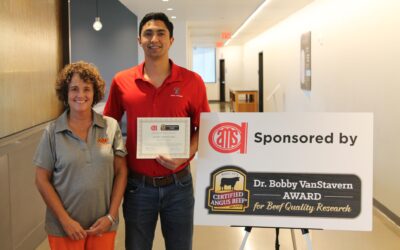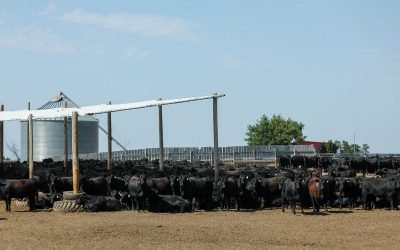
Hot topic, cool solutions
Holistic approach to heat tolerance
by Miranda Reiman
Many challenges in the beef community are tackled with a two-pronged approach: genetics and management.
Heat stress should be no different, says Megan Rolf, Oklahoma State University Extension beef geneticist.
“Certainly from the feedlot side there has been a lot of work done on mitigation strategies, and I think we have a real opportunity in the cowherd to use genetics to work on adapting cows to the different environments,” she says.
The animal scientist outlines some of those possibilities in her research review, “Genetic Selection for Heat Tolerance in Cattle.”
For helping animals through heat events, many of the tips such as shading and altering feeding schedules, apply to cattle on feed. Cowherds already have the distinct advantage of natural shade, like trees, and green grass that absorbs less sun than feedyard pens.
But interventions are also harder to manage at that level.
“Because they’re out on pastures and living on grass, they’re really not in a controlled environment where you can set up sprinklers, for example,” Rolf notes.
That’s why she and other researchers gathered with cattlemen and beef community partners more than a year ago to discuss the role of genetics in heat tolerance.
It all starts at a cellular level and cattle genetics plays a role in heat stress.
“Heat stress responses are controlled by lots of small mutations, spread all throughout the genome,” Rolf says, noting it could be a different fold in the protein due to a slight tweak in an amino acid string. “Just like weights and other production traits, it can be these little things that change a small molecular mechanism, but cumulatively they can have a big impact.”

Much of the current research comes from the dairy production side, because data is easier to gather in those intensively managed herds.
“Heat tolerance is a heritable trait, so genetic selection can be utilized to increase heat tolerance,” the paper notes.
The key to a selection program is defining the right phenotype. Two in the scientific literature are respiration rate (breaths per minute) and body temperature regulation. Both are heritable traits, but there are several practical disadvantages to selection. Respiration rate is very labor-intensive and body temperature regulation requires specialized equipment, Rolf says.
Location also matters. The best bulls for heat tolerance in the Midwest might be different than the best set for the Southeast, for example.
“When you have environmental differences that impact genetics, you have an interaction,” she says. In a favorable environment, there will be one outcome. “When you move those bulls and generate progeny in a really challenging environment, progeny performance might be different.”
Adaptability can be increased by crossbreeding with a tropically adapted breed, or by improving the traits related to tolerance in Bos taurus breeds that have distinct performance and carcass quality strengths.
Results from one paper using simulated data suggested it might require fewer generations to take a high-performance breed and make it more heat tolerant, than to take an already-heat-tolerant breed and make it more favorable for some performance traits.
To make that significant improvement, there are a lot of questions: What are the best and most realistic measures to collect? Would it be easier to use the measures breed associations are already tracking that are collected in different environments? Should a selection index be created to balance selection for heat tolerance and performance traits?
“It’s a high-hanging fruit, but there are some options and possibilities,” Rolf says. “We have to consider thermo-tolerance really comprehensively with other treats. I think we can make progress with improving heat tolerance without making sacrifices in production traits, but we have to consider them holistically.”
Today, particularly in the Southeast, some cattlemen watch hair shedding, which could impact calves later on. One area study showed a 25-pound increase in calf weaning weight from cows that shed their hair quickly.
“There’s no national genetic evaluation but hair shedding is heritable, so a producer could go out and take a look and try to keep replacement females that tend to shed hair earlier in the season,” she says. “That’s a win-win, because you’re getting an advantage in terms of increasing heat tolerance and you get that advantage in weaning weight.”
The Angus Foundation is also funding broader research at the University of Missouri on adapting cattle and genetic selections to better fit nine regions across the U.S., furthering both animal wellbeing and producer profit in concert.
Starting at the beginning would be a boon to the entire system, Rolf says, because improving heat tolerance in herds should create progeny with increased ability to adapt in the stocker and feeding phase.
“Anytime we’re trying to produce a great product for a consumer, it’s a combination of a lot of different factors,” she says. “Everything from the genetics and mating decisions all the way to the management choices you make. Anytime we can do things that reduce the stress on those animals, that’s going to help translate into a good quality product for the consumer.”
The complete research paper is available at www.cabcattle.com/research.
You may also like
Certified Angus Beef Recognizes Beef Quality Research
First-place honors go to Andres Mendizabal, an international student pursuing a Ph.D. in animal science at Texas Tech University. His research is titled, “The Accuracy of USDA Yield Grade and Beef Carcass Components as Predictors of Red Meat Yield.”
Not all good days are sunny and warm
Stress of any kind affects performance and health, but also well-being and behavior, a special focus for CSU animal scientist Lily Edwards-Callaway. Her team’s literature review found shade benefits vary by location, structure type and the weather.
Flavor’s secret ingredient
As a moderately to highly heritable trait, marbling is something that cattlemen have a lot of ability to manage. It also happens to be one of the major contributors to beef flavor. Texas Tech University meat scientist Jerrad Legako spoke about the topic at the 2020 American Society of Animal Science meetings.



